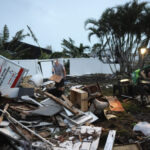California’s $1 billion citrus industry suffered record-low temperatures this past weekend, and agriculture officials continue to worry about widespread crop destruction.
Counties where most of the state’s oranges, lemons and tangerines are grown saw temperatures plummet into the teens to mid-20s both in the pre-dawn hours of Saturday and Sunday, according to the National Weather Service.
“It was a very bad night,” said Nancy Lungren, spokeswoman for the California Department of Food and Agriculture.
Damage to citrus groves in the San Joaquin Valley and Southern California was “widespread” and “significant,” Lungren said. But the full impact would not be known until inspectors had a chance to check fruit picked after the cold snap began Friday.
State officials asked fruit packers to keep produce harvested during the freeze off the market for five days so they could look for quality problems and keep damaged fruit off store shelves.
“If it turns to slush, that’s bad fruit, and they’ll dispose of it,” Lungren said.
Citrus growers rushed to pick as much fruit as possible before the cold weather hit. That should keep citrus supplies steady for the next week to 10 days, said Dave Kranz, a spokesman for the California Farm Bureau Federation.
Forecasters had predicted the mercury would dip below freezing starting on Saturday, with a freeze watch remaining in effect through Tuesday morning.
Starting Wednesday, cloud cover from the Pacific coast could trap heat and increase temperatures to slightly above freezing, National Weather Service meteorologist Cindy Bean predicted on Sunday.
Farmers said they would continue to burn bonfires, blow warmer air through 30-foot wind machines, and spray trees with warm irrigation water in attempt to protect crops. A severe cold snap can destroy crops, leave hundreds of farmworkers unemployed and have long-term effects if trees are damaged.
The industry took two years to recover from a 1990 freeze that lasted a week, said Joel Nelsen, president of California Citrus Mutual, a 2,000-member trade organization. A three-day freeze in December 1998 destroyed 85 percent of California’s citrus crop, a loss valued at $700 million.
Officials estimated the value of the 2007 citrus crop still on the trees at $960 million.
Record lows were reported Sunday throughout Southern California, including downtown Los Angeles, which hit 36 degrees, breaking a record in place since 1932. Long Beach hit 31 degrees, beating the record set in 1963. A 3-degree reading in Lancaster, about 70 miles northeast of Los Angeles, shattered the old record of 10 degrees, also set 1963.
In Bakersfield, temperatures tied the record low at 25 degrees, according to the weather service.
On Friday, Gov. Arnold Schwarzenegger issued an emergency proclamation that made more state funds available to counties coping with cold weather. More than 1,300 people have sought shelter from the subfreezing temperatures at warming centers opened by the California National Guard throughout the state, said Greg Renick, a spokesmen for the Governor’s Office of Emergency Services.
No deaths have been linked to the cold snap so far, Renick said.
Was this article valuable?
Here are more articles you may enjoy.

 Here Comes Another Busy Atlantic Hurricane Season, But Will It Be as Crazy as 2024?
Here Comes Another Busy Atlantic Hurricane Season, But Will It Be as Crazy as 2024?  Will Workers’ Comp Benefit from ‘Most-Favored-Nation’ Drug Pricing?
Will Workers’ Comp Benefit from ‘Most-Favored-Nation’ Drug Pricing?  Four Ex-VW Managers Convicted in Germany Over Diesel Scandal
Four Ex-VW Managers Convicted in Germany Over Diesel Scandal  DIY Home Inspections? They Are Taking Over, Firms Say
DIY Home Inspections? They Are Taking Over, Firms Say 